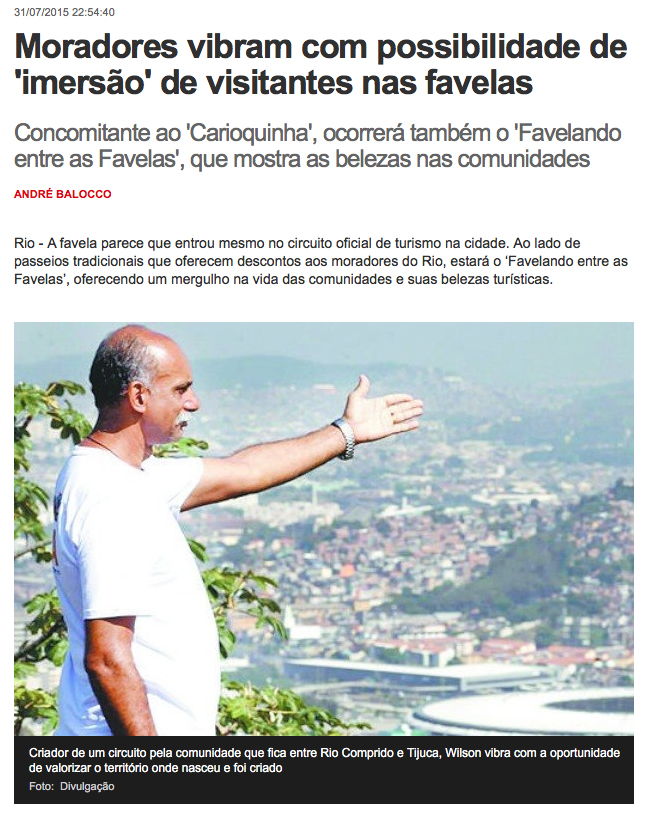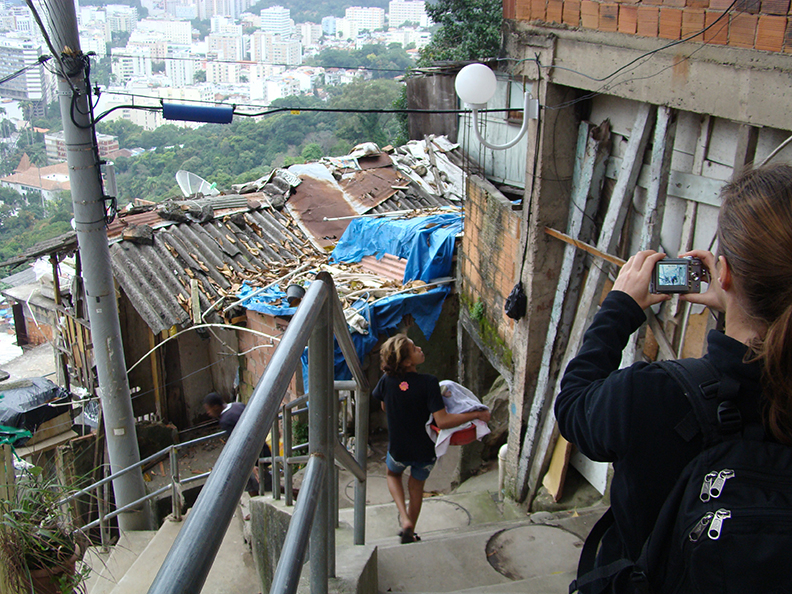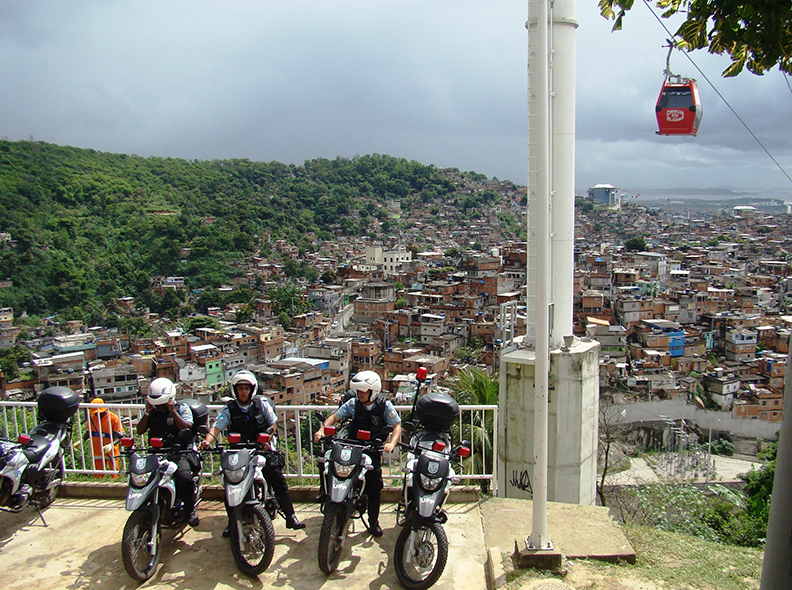BY BIANCA FREIRE-MEDEIROS
July 31, 2015. O Dia, one of Brazil’s major newspapers, announces that residents from three favelas in Rio de Janeiro are offering a package of “tourism experiences” for visitors interested in an authentic “cultural exchange”: the Favelando entre as Favelas tour. The experience includes not only a guided tour by a local resident, but also caipirinhas and Brazil’s national dish, feijoada, and promises the visitor the possibility of spending one or two days (lodging optional) as a true favelado. While the newspaper chooses the supposedly neutral term comunidade, instead of the highly charged term favela, the tourism promoters evoke the charged name twice, twisting the noun (favela) into a verb (favelando) whose literal translation would be slumming. In doing so, they remind us of the fascinating connections between tourism practices that occur in present-day Rio de Janeiro favelas and the practice of “slumming” that took place in poor and segregated territories in London, Paris, and New York at the turn of the nineteenth century.

favelas,” O Dia, July 31, 2016.
A Fashionable Mania
In 1884, the Oxford Dictionary defined slumming as “to visit slums especially out of curiosity or for charitable purposes.” On September 14 of that same year, New York Times headlines announced, “Slumming in This Town: A Fashionable London Mania Reaches New-York.” Throughout the Times article, different parts of the city were named as places of interest to the slummer. So-called black and immigrant neighborhoods were vividly recommended as offering precarious living conditions and explicit promiscuity. It was also noted that, in the English capital, slumming had generated a greater awareness of the suffering of the poor, leading to a series of health and sanitation reforms. Equivalent actions, the newspaper argued, were to be promoted by charitable New Yorkers. Bursting with racist tropes of domestic imperialism that linked the poor to the exotic Other, the article wrapped up with a recommendation to readers—potential slummers—to wear “plain and homely” clothing and to have someone familiar with the neighborhoods accompany them, someone who would “protect ladies of the party from insult and the gentlemen from violence.”
Practitioners of slumming spanned a considerable spectrum: elite politicians, clerics, merchants, single young women committed to the church, politically engaged feminists, “rescuers,” journalists, and social workers. Slums were sufficiently unknown and exotic to these visitors as to allow slummers to be labeled genuine travelers; too often indulging in ethnic stereotyping, many referred to slum dwellers as “natives” and identified explicitly with the civilizing enterprises of colonizers in distant lands.

Many slummers shared their findings on the sociability of those “dark zones” of the city, providing a moralized landscape of slum stereotypes. In his classic How the Poor Live, originally published in 1883, Englishman George Sims shares a conflict often present in other slummers’ narratives: “I hesitate to repel the reader, and, unfortunately, the best illustrations of the evils of overcrowding are repulsive to a degree.” The line between what Sims called “a revelation of the truth about the poor” and sheer sensationalism was not always clear. Besides, slummers and philanthropists were concerned that the sensationalist exposés could spread a feeling of hopelessness rather than solidarity.
Slumming was not only documented in written texts: a few slummers also took advantage of the new medium of photography to create an interpretative frame for potential visitors and to provide proof of their own claims. Among the most remarkable uses of photography within the context of slumming is, without doubt, the work of Jacob Riis. Highly popular in his time, Riis collapsed the distinction between morality and marketing, using photographs as documents of social reality and as tools for galvanizing the sympathy of potential donors. In 1889, he published the best-selling How the Other Half Lives, a “kind of a slum tour,” as Yochelson and Czitrom (2007) accurately suggest. A complex amalgamation of technologically enhanced strategies and narrative tools allowed Riis to present his photographs, although staged, as sheer reality.
The “slummer’s gaze” walked that fine line between emotional expression and exploitation, producing conflicted representations that, if not necessarily raising questions about causes and interdependencies, at least suggested that action should be taken. These representations speak loudly of the elite’s own needs, desires, and values, which, in turn, reinforced the slummer gaze itself.
In 1928, US sociologist Nels Anderson observed in a rather pessimistic tone, “Having come into vogue with the wave of humanitarianism that swept the country in the 1880s and 90s, suddenly, with the decline of slumming as philanthropic pastime, the word [slum] became taboo, but the slum remains.” Slumming had indeed ceased to be a fashionable activity, only to return on a global scale a century later.
Crossing the city and its social boundaries, slummers anticipated values, principles, and practices that are part of contemporary poverty tourism—be it in Cape Town, Mumbai, Jakarta, Nairobi, or Rio de Janeiro, where favela tourism comprises a most popular enterprise.
The 1990s and Beyond
The Rio 92 Earth Summit, which gathered more than one hundred heads of state and ten thousand on-site journalists, was the trigger for the favelas’ becoming tourist destinations. While the army parked war tanks at the entrance of favelas, like Rocinha, that were located closer to the main conference venues, Greenpeace and some local grassroots organizations promoted a tour of the community for more than 200 participants willing to have a closer encounter with the effects of socioeconomic inequality. Private tourism promoters picked up on this new interest and, little by little, favela tourism became a profitable business.

From then on, favelas have been invaded by international tourists eager to experience what they have seen in fictional films or documentaries, and what they believe to be the realities of Brazilian society: poverty and violence, but also samba and unbounded exuberance. Meanwhile, a series of media representations of the favela as simultaneously hip, cool, excitingly dangerous, and colorfully exotic circulate the globe at an accelerating pace.
For many years, favela tours were highly criticized by the Brazilian government, the media, and most upper-class Brazilians, who viewed favela tourism activities as the perverse outcome of a combination of three variables: the unbounded greed of tourism promoters, morbid voyeurism on the part of tourists, and the economic despair of favelados. In contrast, on empirical grounds, what one finds is a rich profile of types of tourists, types of tours, and favelados’ opinions about them.
In the context of the long list of mega events that Rio de Janeiro has hosted and will be hosting, favela tours began to be officially embraced under the principles of city marketing. Two apparently incompatible logics prevailed at the same time: On one hand, favelas were “embraced” not only as territories of touristic potential and economic opportunity, but also as a fundamental part of the Brazilian national myth, so eloquently summarized during the opening ceremony of Rio’s Olympic Games, where Brazil’s favelas were showcased as the birthplace of most of its popular culture. On the other hand, those same territories, including their populations, were deemed either invisible or disposable in the context of these same mega events. In both cases, tourism was one of the most important driving forces producing “social justification” (to use a term from French sociologists Boltanksi and Thevenot) for all sorts of interventions, from beautification measures to draconian removals.

Morro da Providência, considered Rio’s oldest favela, offers us perhaps the best example of how these two apparently contradictory logics could overlap. It is situated on a steep hill not far from the Porto Maravilha, one of the most cost-intensive urban development projects of the Olympic Rio. In order to build a cable car system showcasing Providência’s spectacular views, the city demolished 800 residential units in the historic favela. This gave rise to massive protests, but residents’ attempts to block the construction work were met with countless human rights violations, as documented by Amnesty International, community-based groups, and the nonmainstream media.
If curiosity about how the poor live does not constitute a novelty, then what is new about favela tourism today? What are the challenges favela tourists and favela residents face in the present?
First of all, there is greater mobility: today’s tourists cross much greater distances than their nineteenth-century counterparts, from the rich north to the global south, to experience iconic sites of poverty. Second, a large number of images and writings on poverty are circulated in the virtual space, facilitating the production and consumption of favelas as tourist destinations. Lastly, favela tours have been completely incorporated into the logic of global capitalism, turning the firsthand encounter with poverty into a commodity with a price defined by professional promoters and paid by (mostly international) tourists.
After a decade of researching favela tourism in Rio de Janeiro, I should say that a major challenge is to find ways for tourism to actually help improve the living conditions in favelas. Although tourism promoters claim that favela tourism creates a variety of sources of income for local residents, so far its impact on poverty alleviation is negligible. Yet, as other researchers have demonstrated, it does have the potential of overcoming stigmatization and discrimination—and this is not negligible when one takes into consideration that favelas and their residents have been criminalized throughout Brazil’s history.
Bianca Freire-Medeiros is professor of sociology at the University of São Paulo and the coordinator of UrbanData, a database on urban Brazil. She was a Tinker Visiting Professor at the Teresa Lozano Long Institute of Latin American Studies during the 2016–2017 academic year.
